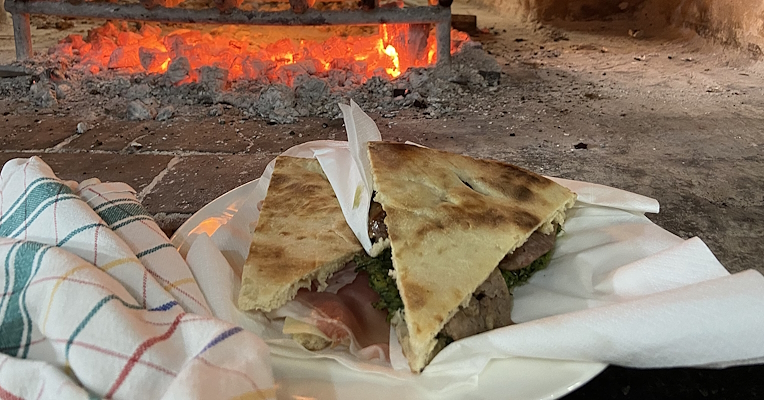Torta al testo is not a focaccia or even a piadina, although at first glance it might seem so. The name comes from the tool with which it is baked, a griddle currently made of cast iron, cement or refractory earth (the "testo," in fact, once made of stone) that is placed over embers or simply on the stove. A simple dough-flour, water, baking soda, a little salt and olive oil-that is transformed into a delicious and certainly inimitable street food, especially when accompanied or stuffed with other excellences of Umbrian food and wine: lamb offal, sautéed chicory with garlic and chili peppers, barbecued sausages, sliced meats and cheeses from Norcia. Also popular is the vegetarian version with stracchino cheese and arugula, but also with all other vegetables, fresh or grilled.
Crispy outside and soft inside, impossible to resist...let's get to work!
Place the flour and baking soda on a pastry board; mix. Add the oil and water a little at a time, continuing to knead the mixture until it is firm. Then the salt, and knead until you have a smooth, homogeneous dough that should be covered and left to rest for half an hour. While the testo is heating up, divide the dough in half and with a rolling pin form two disks about 2 cm thick. When the griddle is very hot, lower the flame slightly and lay the cake on it. Prick the surface with the tines of a fork and bake, turning occasionally, for 5 to 6 minutes on each side. Remove from the heat, letting it cool a little, and cut it into wedges. Stuff to taste-with the traditional herb and sausage, with ham or just your favorite vegetables in its vegetarian version-and enjoy!
Fun fact: same product, different names
The torta al testo, as it is called in the areas around Perugia, takes on different names depending on the various parts of the region where it is prepared: "Crescia" in Gubbio, "Pizza sotto il fuoco" in Terni, "Ciaccia" in Città di Castello.




























